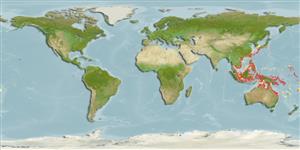>
Gobiiformes (Gobies) >
Gobiidae (Gobies) > Gobiinae
Etymology: Priolepis: Greek, prio = to saw + Greek,lepis = scale (Ref. 45335); nuchifasciata: Name from Latin nucha meaning nape and fascia meaning band, referring to the banding pattern on the head; noun in apposition (Ref. 9018).
More on author: Günther.
Environment: milieu / climate zone / depth range / distribution range
Ecologia
marinhas; estuarina associadas(os) a recifes; não migratória; intervalo de profundidade 5 - 30 m (Ref. 90102). Subtropical
Western Pacific: confined in the area, Australia, New Guinea, Indonesia, Philippines to Hong Kong, westward to the Gulf of Thailand; probably in Vietnam; questionable in Oman (unreported specimens).
Tamanho / Peso / Idade
Maturity: Lm ? range ? - ? cm
Max length : 4.0 cm TL macho/indeterminado; (Ref. 9002)
Descrição suscinta
Chaves de identificação | Morfologia | Morfometria
Espinhos dorsais (total) : 6 - 7; Raios dorsais (total) : 7 - 11; Espinhos anais: 1; Raios anais : 6 - 8. Distinguished from its congeners in having a pelvic fraenum and branched dorsal-fin rays (Ref. 9018); characterized by reddish to mauve with dark scale margins forming network on side of body; head and upper back below dorsal fin with series of dark-edged pale grey to whitish bars; pair of bars found anterior to pectoral fin forming inverted "Y"; sometimes with yellow head; longitudinal scale series 23-26; ctenoid body scales to level of base of pectoral fin; predorsal, cheek, opercle, prepelvic area and base of pectoral fin without scales; absence of vertical rows of papillae on cheek; depth of body 3.0-3.7 in SL (Ref. 90102).
Found in rocky estuary reefs, in small caves, usually in pairs (Ref. 9002). Cryptic (Ref. 90102).
Ciclo de vida ou comportamento de acasalamento
Maturidade | Reprodução | Desova | Ovos | Fecundidade | Larvas
Kuiter, R.H., 1993. Coastal fishes of south-eastern Australia. University of Hawaii Press. Honolulu, Hawaii. 437 p. (Ref. 9002)
Status na Lista Vermelha da UICN (Ref. 130435: Version 2024-1)
Ameaça para os humanos
Harmless
Uso pelos humanos
Pescarias: sem interesse
Ferramentas
Relatórios especiais
Baixar XML
Fontes da internet
Estimates based on models
Preferred temperature (Ref.
123201): 24.7 - 29.3, mean 28.6 °C (based on 2079 cells).
Índice de diversidade filogenética (Ref.
82804): PD
50 = 0.5000 [Uniqueness, from 0.5 = low to 2.0 = high].
Bayesian length-weight: a=0.01023 (0.00477 - 0.02194), b=3.01 (2.83 - 3.19), in cm total length, based on LWR estimates for this (Sub)family-body shape (Ref.
93245).
Nível Trófico (Ref.
69278): 3.1 ±0.3 se; based on size and trophs of closest relatives
Resiliência (Ref.
120179): Elevada, tempo mínimo de duplicação da população menor que 15 meses (Preliminary K or Fecundity.).
Fishing Vulnerability (Ref.
59153): Low vulnerability (10 of 100).
Nutrients (Ref.
124155): Calcium = 161 [58, 455] mg/100g; Iron = 1.28 [0.55, 2.76] mg/100g; Protein = 19.2 [17.1, 21.0] %; Omega3 = 0.271 [0.100, 0.676] g/100g; Selenium = 11.9 [3.8, 32.9] μg/100g; VitaminA = 72.6 [14.4, 320.2] μg/100g; Zinc = 2.51 [1.38, 4.23] mg/100g (wet weight);
